Abstract
This study aims to provide information to improve the performance of athletes comparing the effects of carbohydrate–electrolyte intake before and during exercise on metabolism and performance in soccer players. The study had a single-blind cross-over design. Drust’s protocol is a soccer-specific intermittent exercise test. The carbohydrate–electrolyte intake experiments were divided into three timings: first, pre-exercise; second, half-time; and third, mixed. Eight participants were included in the data analysis (age: 21.32 ± 1.19 years; BMI: 22.69 ± 1.91 kg/m2; height: 176.5 ± 7.52 cm; weight: 69.5 ± 9.18 kg; Vmax: 16.75 0.71 km/h). The results of the mixed test showed a significantly lower respiratory exchange ratio than those of the placebo and half-time tests (p < 0.05). The mixed test showed significantly more fat oxidation than the half-time test (p < 0.05). The running times are placebo (422.13 ± 133.44 s) and mixed (677.38 ± 217.75 s), and the distances are placebo (1577.25 ± 517.02 m) and mixed (2530.00 ± 832.71 m) (p < 0.05). The mixed test showed a significantly lower rating of perceived exertion than the placebo test (p < 0.05). Carbohydrate oxidation and heart rate showed no significant differences between the experiments (p > 0.05). The exercise protocol in this study showed the metabolic response of soccer players to intermittent high-intensity exercise and subsequent endurance exercise. In conclusion, it can be seen that the intake of carbohydrate–electrolytes improves the performance of soccer players, and the effect varies depending on the timing of carbohydrate–electrolyte intake.
1. Introduction
Athletes are constantly looking for ways to maximize their potential and improve their performance. Ergogenic aids are defined as substances that are used to improve performance by increasing energy supply [1]. Ergogenic aids supplement athletes’ insufficient meals, meet the needs of depleted nutrients through high-intensity training, and improve exercise performance by improving endurance, shortening recovery time, and preventing fatigue, disease, and infection [2]. Carbohydrate (CHO) intake pre-exercise, during exercise, and post-exercise plays a critical part in an athlete’s performance. Many studies have consistently proven the ergogenic effects of CHO supplements during continuous moderate- to high-intensity exercise [3]. CHO intake before exercise can improve exercise ability compared to exercise in a fasting state. In addition, CHOs are a significant energy source for performing moderate- and high-intensity exercise [4].
Not all CHOs are equal; some are used more rapidly than others, and those are the ones we need for optimal performance [5]. CHO intake pre-, during, and post-exercise plays a critical part in an athlete’s performance. The timing and amount of CHOs are important when developing a fueling plan. Each athlete should follow a tailored plan based on their body weight, the duration and intensity of the bout of exercise, as well as their gut tolerance. The human body cannot use more than 60 g/h of a single CHO [6]. For exercise lasting less than 30 min, there really is no need to ingest carbohydrates during exercise. However, for events or exercises lasting longer than 30 min, the amount and type of carbohydrates ingested during exercise are dependent on the duration and intensity of the exercise [7]. The ingestion of carbohydrates, even in small amounts, can improve performance during long-term exercise (>2 h) [8]. In addition, ingesting a CHO supplement ten minutes before an exercise will result in better exercise performance [9]. Studies have proven that an intake of 30 g–60 g of CHOs every hour is the most effective in sports with a duration of 60–150 min. Despite studies proving the beneficial effects of CHOs consumed before or during exercise, the optimal intake method and types of CHOs are not well known [10].
Soccer is a high-intensity sport that lasts more than 90 min. Many studies recommend taking CHO supplements because muscle glycogen and blood sugar levels drop to the point of affecting performance during the game. A potential strategy to overcome the limited opportunities to consume CHOs during a soccer match is to administer a highly concentrated CHO–electrolyte solution [11]. The consumption of a CHO–electrolyte solution during prolonged exercise is also beneficial for attenuating dehydration and improving performance. To fuel provision and prevent dehydration, 6–12% CHO–electrolyte beverages are recommended to maintain osmotic balance and decrease soccer-specific fatigue [12]. Practical recommendations on the type of CHO intake and the appropriate CHO–electrolyte intake are required to facilitate gastric emptying and compensate for sweat loss [13].
Studies to improve soccer players’ performance are considered important, and a lot of them are being conducted. In addition, soccer has been found to have an effect on the intake of CHOs, as the results of several studies have shown, and the need for proper CHO intake is being emphasized. Currently, CHO intake during exercise has become a common practice among athletes in many other sports with diverse durations and intensities of exercise. However, there are few studies on the proper timing of CHO intake in soccer-specific exercise. Accordingly, this study aims to provide information to improve the performance of athletes by comparing the effects of CHO–electrolyte intake consumed before and during exercise on metabolism and performance in soccer players.
2. Materials and Methods
2.1. Participants
Eight male soccer players attending K University in Seoul were recruited as subjects for this study. The method of the study was sufficiently explained to all subjects, and the subjects gave written informed consent to the study, which had been approved by the University of Kwangwoon Bioethics Committee. To safely proceed with the soccer-specific exercise test, a physical activity readiness questionnaire was prepared in advance to determine whether the test could proceed. As a result of the questionnaire, all eight participants were not limited to participating in the experiment. Only one out of the eight participants smoked (20 per week), and five out of the eight consumed alcohol, but the amount was not large (no more than five glasses per week). The general characteristics of the subject are as follows: age, mean ± standard deviation (SD) (21.32 ± 1.19); weight, mean ± SD (69.5 ± 9.18); height, mean ± SD (176.5 ± 7.52); BMI, mean ± SD (22.69 ± 1.91); Vmax, mean ± SD (16.75 ± 0.71).
2.2. Experimental Design
All subjects completed four experimental tests. All experimental tests were completed in the same laboratory and under the same environmental conditions. The subjects were instructed to refrain from intense physical activity and were also required to refrain from alcohol, caffeine, and smoking consumption for 24 h before each experimental test [14]. On the day of the experiment, the participants reported to the laboratory after fasting overnight (≥10 h). The study had a single-blind cross-over design. In four experiments (placebo; pre-exercise; half-time; mixed), two subjects participated weekly for each experiment, and eight subjects were randomized (Figure 1). On the day of the experiment, a stable condition was determined for 10 min after athletes arrived at the laboratory, and then they took a CHO–electrolyte solution or a non-CHO–electrolyte placebo within 5 min before the 15 min soccer-specific intermittent exercise test [15]. There was a 15 min rest time 45 min after the start of the exercise, which is similar to the half-time of a soccer match. A five-minute warm-up at 8 km/h followed by five minutes of stretching was performed prior to the test [16]. Respiratory gas and heart rate (COSMED Quark CPET, Rome, Italy) were continuously measured during the soccer-specific exercise tests. Ratings of perceived exertion (RPE) were measured every 15 min on the Borg scale [17], divided into steps 1 to 10 [18] (Figure 2). Respiratory exchange ratio (RER), CHO oxidation, and fat oxidation were expressed by an equation using the measured oxygen consumption (VO2) and carbon dioxide production (VCO2).
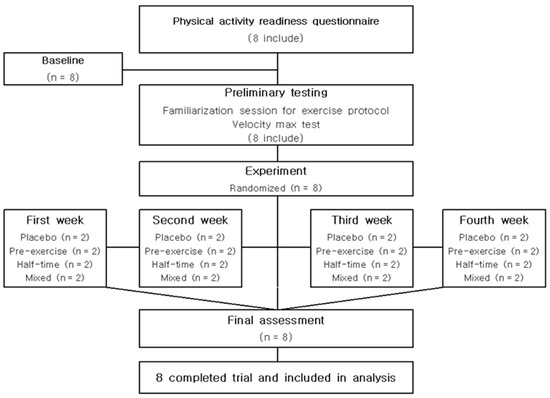
Figure 1.
Flow chart in the study.
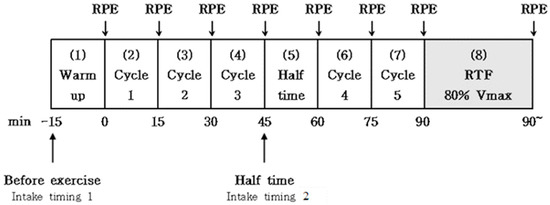
Figure 2.
This figure shows a schematic representation of the experimental protocol. RTF: run time fatigue; RPE: ratings of perceived exertion.
2.3. Preliminary Testing
Preliminary testing included a velocity max (Vmax) test and a familiarization session for the high-intensity intermittent exercise protocol. After the preliminary test, each subject went through four experiments at intervals of 7 days or more in a balanced single-blind cross-over design [16]. Vmax were determined using an incremental running test to exhaustion on a treadmill, accordingly [19]. On the day of the preliminary test, a stable condition was maintained for 10 min after arriving at the laboratory. A five-minute warm-up at 8 km/h followed by five minutes of stretching, was performed prior to the test. The test started at 10 km/h, and the speed was increased by 1 km/h every minute until exhaustion. The measured Vmax is used to set the speed of the run time fatigue (RTF) cycle in soccer-specific intermittent exercise protocol [20].
2.4. Exercise Protocol
The soccer-specific intermittent exercise protocol was applied for the laboratory-based study [11]. This exercise protocol was made to simulate the exercise intensity and physiological demands of soccer match (Drust et al. (2000) [21]). The experimental protocol design was composed of 5 × 15 min identical intermittent exercise cycles, immediately followed by run time to fatigue at 80% Vmax. The total duration of the 5 cycles was 75 min of intermittent exercise interposed with a 15 min rest period at half-time. The subjects were to run to the point of exhaustion, at which time they could not maintain their relative speed (Vmax 80%) in the last cycle [15]. A treadmill (COSMED T-150, Rome, Italy) and its software (COSMED Quark CPET Omnia, version 1.6.5, Rome, Italy) were used to simulate the exercise protocol of a soccer-specific by alternating between periods of standing, walking, jogging, running, and sprinting based on the protocol of Drust et al. (2000) [21]. The percentage of time spent at each speed was based on the time–motion analysis of professional soccer players. Spend about 7% of the match in a standing position, 56% of the match walking (6 km/h), 30% of the match jogging (10 km/h), 4% of the match running (17 km/h), and 3% of the game sprinting (21 km/h) [22] (Figure 3).
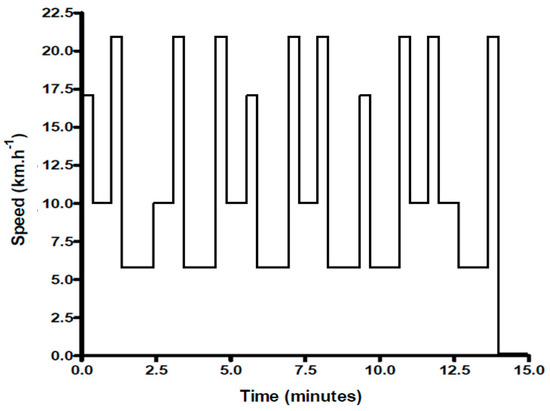
Figure 3.
Graphical representation of one 15 min cycle of the soccer−specific intermittent exercise protocol.
2.5. Details of Experimental Carbohydrate Conditions
CHO–electrolyte intake experiments are divided into three timings. First, pre-exercise (15 min before beginning the soccer-specific exercise test); second, half-time (immediately upon finishing the first half); and third, mixed (15 min before starting the soccer-specific exercise test and the second half) [23]. The total amount of ingested CHOs was 60 g [7], and in the mixed intake experiment, the amount was divided into half and consumed at intake timing 1 and intake timing 2. The CHO–electrolyte consumed is a product approved for sale (IAMPOTIN Energy gel 80, Seoul, Korea). The components of the product are 20 g of CHOs, less than 5 mg of sodium, and less than 0.5 g of protein. The placebo was ingested 15 min before the soccer-specific exercise test (500 mL). The placebo added an apple flavoring of 1% of the solution to produce apple scents and tastes such as CHO gel (NIF, Food synthetic flavoring, propylene glycol 88.51%, synthetic flavoring). The concentration of CHO–electrolytes was designed to be 12%, and electrolyte intake was the same in all experimental tests (500 mL).
2.6. Statistical Analysis
Results are reported as the mean ± SD. One-way ANOVA was used to analyze multiple comparisons between the experimental tests, analysis of variance followed by the Tukey post-hoc. All statistical significance was considered p < 0.05. All statistical analyses were conducted using IBM Windows SPSS Statistics (Version 25, New York, NY, USA).
3. Results
3.1. Respiratory Gas and Physiology Variable
3.1.1. Respiratory Exchange Ratio
As a result of the one-way ANOVA analysis of variance on RER, the experimental tests showed a significant main effect in means RER 2 (the number after the variable nouns means the number in parentheses in Figure 2, and RER 1 is the means ± SD of RER measured during the warm-up cycle of 15 min., e.g., RER 2: RER cycle 1; RER 5: RER half-time cycle 2; RER 8: RER RTF cycle), RER 3, and RER 4 (p < 0.05) (Figure 2). The Tukey post hoc test revealed that RER 2 was significantly lower in the mixed test when compared with the placebo test (p < 0.05). Significantly less RER 3 was observed in the mixed test compared with the placebo and half-time test (p < 0.05). And the mixed test showed significantly less RER 4 than the half-time test (p < 0.05) (Figure 4). The RER (2, 3, and 4) means ± SD are placebo (2: 94.713 ± 3.10, 3: 92.925 ± 2.37), half-time (3: 92.90 ± 2.30, 4: 91.875 ± 2.10), and mixed (2: 90.10 ± 3.79, 3: 88.95 ± 3.29, 4: 88.20 ± 3.03).
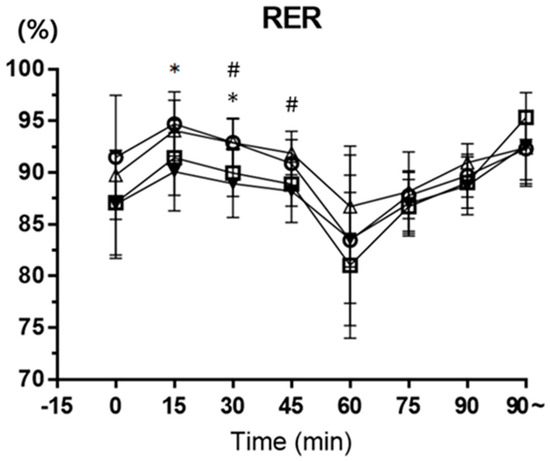
Figure 4.
−○− placebo, −□− pre-exercise, −△− half-time, and −▼− mixed. This figure shows the RER collected during soccer-specific intermittent tests. Data are shown in means ± SD, and one−way ANOVA was performed. Tukey test was used to calculate p values. Mixed test *, p < 0.05 compared with placebo test. Mixed test #, p < 0.05 compared with half−time test.
3.1.2. Fat Oxidation
As a result of the one-way ANOVA analysis of variance on fat oxidation, the experimental tests showed a significant main effect in the mean fat oxidation 3 and fat oxidation 4 (p < 0.05). The Tukey post hoc test revealed that fat oxidation 3 was significantly higher in the mixed test when compared with the placebo and half-time test (p < 0.05). Significantly more fat oxidation 4 was observed in the mixed test than the half-time test (p < 0.05) (Figure 5). The fat oxidation (3, 4) means ± SD are placebo (3: 0.26 ± 0.08), half-time (3: 0.28 ± 0.09, 4: 0.32 ± 0.09), and mixed (3: 0.42 ± 0.12, 4: 0.47 ± 0.11).
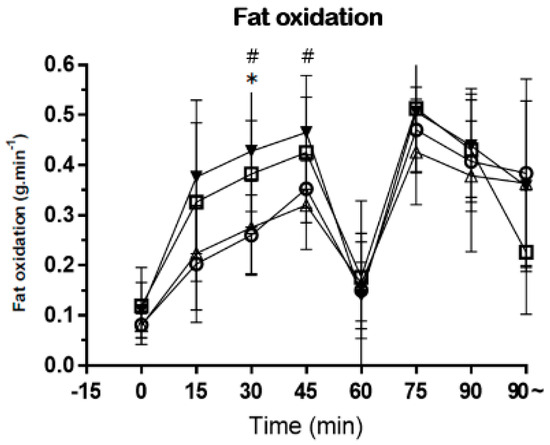
Figure 5.
−○− placebo, −□− pre-exercise, −△− half-time, and −▼− mixed. This figure shows the fat oxidation collected during soccer-specific intermittent tests. Data are shown in means ± SD and one−way ANOVA was performed. Tukey test was used to calculate p values. Mixed test *, p < 0.05 compared with placebo test. Mixed test #, p < 0.05 compared with half−time test.
3.1.3. Carbohydrate Oxidation
As a result of the one-way ANOVA analysis of variance on CHO oxidation, the experimental tests showed a significant main effect in means pf CHO oxidation 3 (p < 0.05). However, the Tukey post hoc test showed no significant differences in CHO oxidation among the tests (p > 0.05). The CHO oxidation means ± SD of cycles one to five are placebo test (2.08 ± 0.26), pre-exercise (1.84 ± 0.163), half-time (2.09 ± 0.194), and mixed (1.83 ± 0.102).
3.1.4. Heart Rate
As a result of the one-way ANOVA analysis of variance on HR, the experimental tests showed no significant main effect in means HR (p > 0.05). The HR means ± SD of cycles one to five are placebo test (153.46 ± 4.467), pre-exercise (147.63 ± 3.984), half-time (149.83 ± 4.455), and mixed (147.56 ± 4.832).
3.2. Exercise Performance
3.2.1. Running Time (RTF)
As a result of the one-way ANOVA analysis of variance on running time, the experimental tests showed a significant main effect on the mean running time (p < 0.05). The Tukey post hoc test revealed that running time was significantly longer in the mixed test when compared with the placebo test (p < 0.05) (Figure 6). The running time means ± SD are placebo (422.13 ± 133.44) and mixed (677.38 ± 217.75).
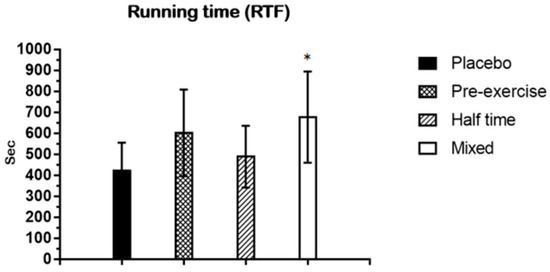
Figure 6.
This figure shows the running time collected during RTF. Data are shown in means ± SD and one-way ANOVA was performed. Tukey test was used to calculate p values. Mixed test *, p < 0.05 compared with Placebo test. Sec: second.
3.2.2. Distance (RTF)
As a result of the one-way ANOVA analysis of variance on distance, the experimental tests showed a significant main effect in the mean distance (p < 0.05). The Tukey post hoc test revealed that distance was significantly more in the mixed test when compared with the placebo test (p < 0.05) (Figure 7). The distance means ± SD are placebo (1577.25 ± 517.02) and mixed (2530.00 ± 832.71).
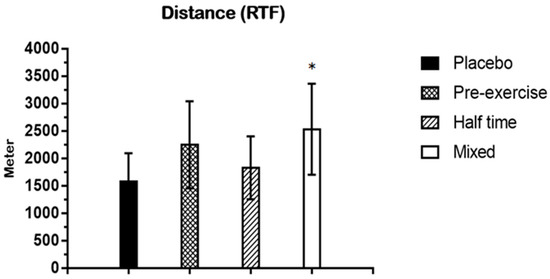
Figure 7.
This figure shows the distance collected during RTF. Data are shown in means ± SD and one-way ANOVA was performed. Tukey test was used to calculate p values. Mixed test *, p < 0.05 compared with placebo test.
3.3. Rating of Perceived Exertion
As a result of the one-way ANOVA analysis of variance on RPE, the experimental tests showed a significant main effect in mean RPE 3 and RPE 7 (p < 0.05). The Tukey post hoc test revealed that RPE 3 was significantly lower in the mixed test when compared with the placebo test (p < 0.05). Significantly less RPE 7 was observed in the mixed test than the placebo test (p < 0.05) (Figure 8). The RPE means ± SD are placebo (3: 5.13 ± 1.13, 7: 5.13 ± 0.74) and mixed (3: 3.50 ± 1.20, 7: 5.25 ± 1.04).
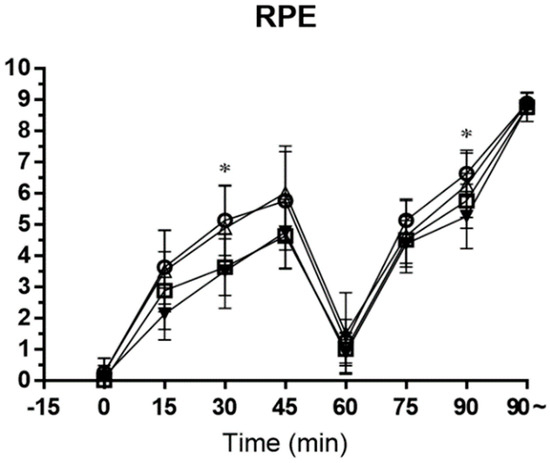
Figure 8.
−○− placebo, −□− pre-exercise, −△− half-time, and −▼− mixed. This figure shows the RPE collected during soccer-specific intermittent tests. Data are shown in means ± SD and one-way ANOVA was performed. Tukey test was used to calculate p value. Mixed test *, p < 0.05 compared with Placebo test.
4. Discussion
An average human has an RER at rest of around 0.8, although this can vary a bit depending on diet and other factors. During a stress test, RER will typically gradually increase to a peak of about 1.2 (again, variable depending on the individual). As a rule of thumb, a resting RER of about 0.7 indicates that fats are being used as the body’s main fuel source, while 1 means mostly CHOs are being used [24]. The experimental tests showed a significant main effect in the means of RER 2, RER 3, and RER 4 (p < 0.05). RER 2 was significantly lower in the mixed test when compared with the placebo test (p = 0.05). Significantly less RER 3 was observed in the mixed test compared with the placebo and half-time test (p < 0.05). And the mixed test showed significantly less RER 4 than the half-time test (p < 0.05). This result is similar to the results of other studies, and it seems that the intake of CHO–electrolyte supports increasing the persistence of exercise by decreasing RER during exercise.
Fat oxidation increases up to 70% VO2max when stationary but decreases with exercise intensity of about 75% VO2max or higher [25,26]. In this study, fat oxidation 3 was significantly higher in the mixed test when compared with the placebo and half-time test (p < 0.05). Significantly more fat oxidation 4 was observed in the mixed test than in the half-time test (p < 0.05). Therefore, subjects recognized the mixed and pre-exercise test as having a relatively low exercise intensity compared to the placebo or half-time test in the first half of the exercise protocol. It is commonly believed that increasing fat utilization and sparing CHO are associated with increased endurance [27,28,29]. Previous studies of long-distance athletes have shown that carbohydrates consumed during exercise increase fat oxidation rates during exercise [30]. However, some of the previous studies had different results from this study. Differences in metabolic regulation between high-intensity intermittent and moderate-intensity endurance exercise may be another reason why the substrate oxidation results differ from previous studies. Therefore, a direct comparison between high-intensity intermittent exercise and endurance exercise is laborious. Therefore, this study is meaningful in that it studied fat oxidation following CHO intake by soccer players during prolonged soccer-specific intermittent exercise.
This study showed no significant differences in CHO oxidation among tests (p > 0.05). Previous studies researching the effects of CHO intake on exercise performance have focused on prolonged endurance exercise. The results of these studies are mixed, and the same is true of the results of this study [31,32,33]. Muscle glycogen stores decrease as exercise progresses, and blood glucose becomes a progressively more important fuel source [34]. Contrastively, muscle glycogen, not blood glucose or free fatty acids, is the principal fuel source during high-intensity exercise [35]. Therefore, the potential for CHO intake to affect blood glucose and free fatty acid concentration may not be as important during high-intensity intermittent exercise when compared to moderate-intensity exercise [36]. Therefore, this study is meaningful in that it studied CHO oxidation following CHO intake by soccer players during prolonged soccer-specific intermittent exercise. However, further research is needed later to prove the difference between CHO oxidation in intermittent, high-intensity, and persistent exercise.
The exercise protocol of this study was chosen because lower muscle glycogen stores have been associated with decreased distance covered and decreased time spent sprinting during the last 15 min of competitive soccer matches [35]. The last 15 min of soccer matches also appear to be critical to the outcome, as a disproportionate number of goals are scored in this period [37]. Therefore, if a CHO–electrolyte intake resulted in increased reliance on fat and decreased reliance on CHOs during soccer-specific intermittent exercise, muscle glycogen stores during the late stages of the match could be preserved, and the RTF running time may be greater. In this study, running time and distance measured during RTF were significantly higher in the mixed test when compared with the placebo test (p < 0.05). In this study, performance improvements were apparent with a CHO supplement at an exercise intensity of 80% Vmax. In particular, the effect was evident in the mixed test in this study. Indeed, this is in agreement with other studies [38,39].
If there is an increased dependence on fat and a decreased reliance on CHO during soccer-specific intermittent exercise, the distance covered on the RTF may be greater. If participants could cover more distance at the same exercise intensity during this period of experimental tests, it is reasonable to assume that CHO–electrolyte intake could affect the outcome [37,40]. These results suggest a potential advantage of endurance performance during soccer-specific intermittent exercise following a mixed intake of CHO–electrolyte. Few studies have evaluated endurance at the end of the soccer-specific intermittent exercise test. Accordingly, it is difficult to make direct comparisons between the performance results from this study and those of previous investigations. However, the previous study provides a basis for comparison. In their study, participants cycled at ~70% VO2max for 120 min and then rode to exhaustion at 100% VO2max [41]. DeMarco et al. (1999) found that the cycling distance to exhaustion was increased in the CHO intake test [41]. However, due to the differences in exercise type, duration, intensity, and character of the performance test, further research is needed to confirm whether CHO–electrolyte provides performance advantages for soccer-specific intermittent exercise performed at the end of a prolonged exercise test.
HR in all experimental tests increased linearly over the course of exercise. This replicates findings from our previous study [42] and from related adult work [43,44]. Although there were no significant differences, the pre-exercise and mixed tests had 5 bpm less HR means ± SD of cycles one to five than the placebo test. In the same intensity of exercise protocol, pre-exercise and mixed tests seem to recognize relatively low intensity compared to placebo tests. The HR tends to be the same as other measurement variables representing exercise intensity, such as RER, fatty oxidation, CHO oxidation, and RPE. The mixed test, in which significantly more RTF running time and distance were collected than the placebo test (p < 0.05), showed similar HR. Therefore, CHO–electrolyte intake appears to increase the persistence of exercise intensity. These results are similar to those of previous studies [44,45].
This study found that ratings of perceived exertion using the Borg RPE scale [17] were lower in the mixed test compared to the placebo test (p < 0.05). It appears that CHO ergogenic aids result in participants recording a lower RPE score at a given exercise intensity or achieving a higher intensity for a given RPE. However, RPE is not designed to assess central fatigue directly, and therefore, this interpretation should be viewed with caution. Although associative, Using RPE to measure subjective recognition of exertion provides some insight into these fatigue processes [46]. However, RPE is not designed to assess central fatigue directly, and therefore, this interpretation should be viewed with caution. In this study, mixed tests were significantly less in RPE 3 and RPE 7 than placebo tests (p < 0.05). Therefore, CHO–electrolyte consumed before exercise can be seen as improving exercise persistence by decreasing the RPE during exercise.
Previous studies in this area have examined continuous, moderate-intensity exercise [39,47]. However, the results of these studies may not be relevant to team sports athletes who are required to perform intermittent activity for extended periods of time. Therefore, this study was unique in that it examined the effects of CHO–electrolyte intake timing on metabolism and performance during prolonged, soccer-specific intermittent exercise. Many studies have investigated the mechanical effects of CHO supplementation on metabolism and performance [48,49,50]. There are many studies that show that carbohydrate intake increases exercise performance, but few have researched the effect of intake timing on exercise performance. In particular, no study has analyzed soccer players by classifying them into three carbohydrate intake timings like this study. Therefore, the results of this study suggest important implications in sports that encompass multiple exercise sessions with limited recovery, such as soccer [51]. In addition, the exercise protocol of this study is a soccer-specific protocol that reflects the exercise characteristics of soccer as much as possible on a treadmill. Therefore, this study is regarded as of high value because it analyzed changes in performance and metabolism according to the timing of carbohydrate intake in soccer players using soccer-specific exercise rules.
However, due to the differences in exercise type, duration, intensity, and character of the exercise test, additional research is needed to prove whether CHO–electrolyte intake provides performance benefits for soccer-specific intermittent exercise performed in the prolonged exercise test. This study used soccer-specific exercise on the treadmill to imitate the demands of a soccer match. Moreover, previous studies have analyzed blood data, but this study has not performed blood collection and analysis [15,52]. Therefore, further studies investigating the effects of CHO intake on metabolism and performance in soccer players will need to analyze blood variables.
5. Conclusions
According to this study, in the soccer-specific intermittent exercise test, CHO–electrolyte intake tests showed lower RER, RPE, and increased fat oxidation, running time, and distance than the placebo test. In particular, there were significant differences between the test that mixed consumed CHO–electrolyte and the placebo. In addition, RER and Fat oxidation, which indirectly indicate endurance performance, were higher in the Mixed experiment than in the half-time experiment. Therefore, it can be seen that the intake of CHO–electrolytes improves the performance of soccer players, and the effect varies depending on the timing of CHO–electrolyte intake. In further study, it should be tried to perform more diverse exercise protocols to establish the effects of CHO intake in soccer-specific intermittent exercise. In addition, further studies investigating the effects of CHO intake on metabolism and performance in soccer players will need to analyze blood variables.
Author Contributions
Conceptualization: K.-W.N., Data curation: J.-H.O. and S.P., Formal analysis: K.-W.N. and J.-H.O., Funding acquisition: K.-W.N., Methodology: S.P. and K.-W.N., Project administration: J.-H.O. and S.P., Visualization: J.-H.O., Writing—original draft: K.-W.N. and S.P., Writing—review and editing: J.-H.O. All authors have read and agreed to the published version of the manuscript.
Funding
This study was conducted using the money of the first author (Ki-Woong Noh), and there was no outside funding.
Institutional Review Board Statement
The study was conducted according to the guidelines of the Declaration of Helsinki and approved by the Institutional Review Board of University of Kwangwoon Bioethics Committee (code: 7001546-20210701-HR (SB)-007-01, Date: 6 August 2021).
Informed Consent Statement
This study was approved by the Bioethics Committee of Kwangwoon University. The method of the study was sufficiently explained to all subjects, and the subjects gave written informed consent, which was approved by the University of Kwangwoon Bioethics Committee.
Data Availability Statement
Data available in a publicly accessible repository that does not issue DOIs for publicly available datasets were analyzed in this study. This data can be found here: (https://figshare.com/articles/dataset/Article_data_Effects_of_the_Timing_of_Carbohydrate_Intake_on_Metabolism_and_Performance_in_Soccer_Players_/23919450, accessed on 7 August 2023).
Acknowledgments
These authors have no support or funding to report.
Conflicts of Interest
We have read and understood your journal’s policies, and we believe that neither the manuscript nor the study violates any of these. There are no conflict of interest to declare.
References
- Bucci, L. Nutrients as Ergogenic Aids for Sports and Exercise; CRC Press: Boca Raton, FL, USA, 1993. [Google Scholar]
- Williams, M.H. Ergogenic and ergolytic substances. Med. Sci. Sports Exerc. 1992, 24, s344–s348. [Google Scholar] [CrossRef] [PubMed]
- Cermak, N.M.; van Loon, L.J.C. The use of CHOs during exercise as an ergogenic aid. Sports Med. 2013, 43, 1139–1155. [Google Scholar] [PubMed]
- Van Loon, L.J.C.; Greenhaff, P.L.; Constantin-Teodosiu, D.; Saris, W.H.; Wagenmakers, A.J. The effects of increasing exercise intensity on muscle fuel utilisation in humans. J. Physiol. 2001, 536 Pt 1, 295–304. [Google Scholar] [CrossRef]
- Jeukendrup, A. A step towards personalized sports nutrition: Carbohydrate intake during exercise. Sports Med. 2014, 44 (Suppl. 1), S25–S33. [Google Scholar] [PubMed]
- Jeukendrup, A.E. Nutrition for endurance sports: Marathon, triathlon, and road cycling. J. Sports Sci. 2011, 29 (Suppl. 1), S91–S99. [Google Scholar]
- Coleman, E.J. Carbohydrate and exercise. In Sports Nutrition: A Handbook for Professionals, 6th ed.; Karpinski, C., Ed.; Academy of Nutrition and Dietetics: Cleveland, OH, USA, 2017. [Google Scholar]
- Currell, K.; Jeukendrup, A.E. Superior endurance performance with ingestion of multiple transportable carbohydrates. Med. Sci. Sports Exerc. 2008, 40, 275–281. [Google Scholar] [CrossRef]
- Iny, J.; Portman, R. Nutrient Timing; Basic Health Publications, Inc.: Laguna Beach, CA, USA, 2004. [Google Scholar]
- Coyle, E.F. Fluid and fuel intake during exercise. J. Sports Sci. 2004, 22, 39–55. [Google Scholar]
- Clarke, N.D.; Drust, B.; Maclaren, D.P. Fluid provision and metabolic responses to soccer-specific exercise. Eur. J. Appl. Physiol. 2008, 104, 1069–1077. [Google Scholar]
- Convertino, V.A.; Armstrong, L.E.; Coyle, E.F. American college of sports medicine position stand: Exercise and fluid replacement. Med. Sci. Sports Exerc. 1996, 28, R1–R7. [Google Scholar] [CrossRef]
- Neufer, P.; Costill, D.; Fink, W. Effects of exercise and carbohydrate composition on gastric emptying. Med. Sci. Sports Exerc. 1986, 18, 658–662. [Google Scholar] [CrossRef]
- Wu, C.L.; Williams, C. A low glycemic index meal before exercise improves endurance running capacity in men. Sports Nutr. Exerc. Metab. 2006, 16, 510–527. [Google Scholar] [CrossRef] [PubMed]
- Kohara, A.; Morishima, T.; Uchida, H.; Ito, T.; Goto, K. Carbohydrate gel ingestion immediately before prolinged exercise causes sustained higher glucose concentrations and lower fatigue. Int. J. Sport Health Sci. 2014, 12, 24–30. [Google Scholar] [CrossRef]
- Little, J.P.; Chilibeck, P.D.; Ciona, D.; Forbes, S.; Rees, H.; Vandenberg, A.; Zello, G.A. Effect of low and high glycemic index meals on metabolism and performance during high intensity, intermittent exercise. Int. J. Sport Nutr. Exerc. Metab. 2010, 20, 447–456. [Google Scholar] [CrossRef] [PubMed]
- Borg, G.A. Psychophysical bases of perceived exertion. Med. Sci. Sports. Exerc. 1982, 14, 377–381. [Google Scholar] [CrossRef] [PubMed]
- Bellei, A.C.; Dacoregio, D.G.; Bianchini, F.; Souza, J.C.G.; Bello, J.M.L.; de Souza Kock, K. Factors associated with abdominal pain in patients submitted to colonoscopy. J. Coloproctology 2017, 37, 306–311. [Google Scholar] [CrossRef]
- Alghannam, A.F. Carbohydrate-protein ingestion improves subsequent running capacity towards the end of a football-specific intermittent exercise. Appl. Physiol. Nutr. Metab. 2011, 36, 748–757. [Google Scholar]
- Simon, A.H.; Richard, J.T.; Timothy, D.M. The oxygen uptake response running to exhaustion at peak treadmill speed. Med. Sci. Sports Exerc. 2003, 35, 663–668. [Google Scholar]
- Drust, B.; Reilly, T.; Cable, N.T. Physiological responses to laboratory-based soccer-specific intermittent and continuous exercise. J. Sports. Sci. 2000, 18, 885–892. [Google Scholar] [CrossRef]
- Ali, A.; Farrally, M. A computer-video aided time motion analysis technique for match analysis. J. Sports Med. Phys. Fit. 1991, 31, 82–88. [Google Scholar]
- Rodriguez-Giustiniani, P.; Rollo, I.; Witard, O.C.; Galloway, S.D.R. Ingesting a 12% carbohydrate-electrolyte beverage before each half of a soccer-match simulation facilitates retention of passing performance and improves high-intensity running capacity in academy players. Int. J. Sport Nutr. Exerc. Metab. 2018, 29, 397–405. [Google Scholar]
- Wingfield, H.L.; Smith-Ryan, A.E.; Melvin, M.N.; Roelofs, E.J.; Trexler, E.T.; Hackney, A.C.; Weaver, M.A.; Ryan, E.D. The acute effect of exercise modality and nutrition manipulations on post-exercise resting energy expenditure and respiratory exchange ratio in women: A randomized trial. Sports Med. 2015, 1, 11. [Google Scholar]
- Achten, J.; Jeukendrup, A.E. Maximal fat oxidation during exercise in trained men. Int. Sports Med. 2003, 24, 603–608. [Google Scholar]
- Romijn, J.A.; Coyle, E.F.; Sidossis, L.S. Regulation of endogenous fat and carbohydrate metabolism in relation to exercise intensity and duration. Am. J. Physiol. Endocrinol. Metab. 1993, 265, E380–E391. [Google Scholar] [CrossRef] [PubMed]
- Graham, T.E. The importance of carbohydrate, fat and protein for the endurance athlete. In Endurance in Sport, 2nd ed.; Shephard, R.J., Astrand, P.O., Eds.; Blackwell Science: Oxford, UK, 2000; p. 197. [Google Scholar]
- Patrick, M.D.; Catherine, S.; Troy, H.; Phil, B.; Steven, E. Physiological Impact of a Single Serving Slow Absorption Carbohydrate on Metabolic, Hemodynamic, and Performance Markers in Endurance Athletes during a Bout of Exercise. J. Strength Cond. Res. 2021, 3595, 1262–1272. [Google Scholar]
- Pitsiladis, Y.P.; Smith, I.; Maughan, R.J. Increased fat availability enhances the capacity of trained individuals to perform prolonged exercise. Med. Sci. Sports Exerc. 1999, 31, 1570–1579. [Google Scholar] [PubMed]
- Rauch, C.E.; McCubbin, A.J.; Gaskell, S.K.; Costa, R.J. Feeding Tolerance, Glucose Availability, and Whole-Body Total Carbohydrate and Fat Oxidation in Male Endurance and Ultra-Endurance Runners in Response to Prolonged Exercise, Consuming a Habitual Mixed Macronutrient Diet and Carbohydrate Feeding During Exercise. Front. Physiol. 2022, 12, 773054. [Google Scholar] [PubMed]
- Burke, L.M.; Claassen, A.; Hawley, J.A.; Noakes, T.D. Carbohydrate intake during prolonged cycling minimizes effect of glycemic index of preexercise meal. J. Appl. Physiol. 1998, 85, 2220–2226. [Google Scholar] [CrossRef] [PubMed]
- Stannard, S.R.; Constantini, N.W.; Miller, J.C. The effect of glycemic index on plasma glucose and lactate levels during incremental exercise. Int. J. Sport Nutr. Exerc. Metab. 2000, 10, 51–61. [Google Scholar]
- Wee, S.L.; Williams, C.; Gray, S.; Horabin, J. Influence of high and low glycemic index meals on endurance running capacity. Med. Sci. Sports Exerc. 1999, 31, 393–399. [Google Scholar]
- Coggan, A.R.; Coyle, E.F. Carbohydrate ingestion during prolonged exercise: Effects on metabolism and performance. Exerc. Sport Sci. Rev. 1991, 19, 1–40. [Google Scholar] [CrossRef]
- Saltin, B. Metabolic fundamentals in exercise. Med. Sci. Sports 1973, 5, 137–146. [Google Scholar] [CrossRef] [PubMed]
- Horowitz, J.F.; Klein, S. Lipid metabolism during endurance exercise. Am. J. Clin. Nutr. 2000, 72, 558S–563S. [Google Scholar] [CrossRef] [PubMed]
- Reilly, T. Endurance aspects of soccer and other field games. In Endurance in Sport, 2nd ed.; Shephard, R.J., Astrand, P.O., Eds.; Blackwell Science: Oxford, UK, 2000; 900p. [Google Scholar]
- Martínez-Lagunas, V.; Ding, Z.; Bernard, J.R.; Wang, B.; Ivy, J.L. Added protein maintains efficacy of a low-carbohydrate sports drink. J. Strength Cond. Res. 2010, 24, 48–59. [Google Scholar] [CrossRef]
- Asako, S.; Tsuyoshi, W.; Yoko, H.; Naomi, H.; Nobuko, H. Carbohydrate Mouth Rinse and Spray Improve Prolonged Exercise Performance in Recreationally Trained Male College Students. Sports 2022, 10, 51. [Google Scholar]
- Bruno, N.M.; Gabriel, V.P.; Fabricio, B.V. Inclusion of sprints during moderate-intensity continuous exercise enhances post-exercise fat oxidation in young males. Appl. Physiol. Nutr. Metab. 2022, 47, 165–172. [Google Scholar]
- DeMarco, H.M.; Sucher, K.P.; Cisar, C.J.; Butterfield, G.E. Pre-exercise carbohydrate meals: Application of glycemic index. Med. Sci. Sports Exerc. 1999, 31, 164–170. [Google Scholar] [CrossRef]
- Phillips, S.M.; Turner, A.P.; Gray, S.; Sanderson, M.F.; Sproule, J. Ingesting a 6% carbohydrate–electrolyte solution improves endurance capacity, but not sprint performance, during intermittent, high-intensity shuttle running in adolescent team games players aged 12–14 years. Eur. J. Appl. Physiol. 2010, 109, 811–821. [Google Scholar] [CrossRef]
- Aline, V.C.; Ronaldo, V.T. Carbohydrate and Glutamine Supplementation Attenuates the Increase in Rating of Perceived Exertion during Intense Exercise in Hypoxia Similar to 4200 m. Nutrients 2020, 12, 3797. [Google Scholar]
- Nicholas, C.W.; Williams, C.; Lakomy, H.K.A.; Philips, G.; Nowitz, A. Influence of ingesting a carbohydrate-electrolyte solution on endurance capacity during intermittent, high-intensity shuttle running. J. Sports Sci. 1995, 13, 283–290. [Google Scholar] [CrossRef]
- Merry, A.B.; Jeffrey, A.R.; George, H.C. Effect of low- and high-carbohydrate diets on swimming economy: A crossover study. J. Int. Soc. Sports Nutr. 2020, 17, 64. [Google Scholar]
- Edwards, A.M.; Mann, M.E.; Marfell-Jones, M.J.; Rankin, D.M.; Noakes, T.D.; Shillington, D.P. Influence of moderate dehydration on soccer performance: Physiological responses to 45 min of outdoor match-play and the immediate subsequent performance of sport-specific and mental concentration tests. Br. J. Sports Med. 2007, 41, 385–391. [Google Scholar] [CrossRef]
- Febbraio, M.A.; Stewart, K.L. CHO feeding before prolonged exercise: Effect of glycemic index on muscle glycogenolysis and exercise performance. J. Appl. Physiol. 1996, 81, 1115–1120. [Google Scholar] [CrossRef]
- Cermak, N.M.; Solheim, A.S.; Gardner, M.S.; Tarnopolsky, M.A.; Gibala, M.J. Muscle metabolism during exercise with carbohydrate or protein-carbohydrate ingestion. Med. Sci. Sports Exerc. 2009, 41, 2158–2164. [Google Scholar] [CrossRef]
- Howarth, K.R.; Moreau, N.A.; Phillips, S.M.; Gibala, M.J. Coingestion of protein with carbohydrate during recovery from endurance exercise stimulates skeletal muscle protein synthesis in humans. J. Appl. Physiol. 2009, 106, 1394–1402. [Google Scholar] [CrossRef] [PubMed]
- Betts, J.; Williams, C.; Duffy, K.; Gunner, F. The influence of carbohydrate and protein ingestion during recovery from prolonged exercise on subsequent endurance performance. J. Sports Sci. 2007, 25, 1449–1460. [Google Scholar] [CrossRef] [PubMed]
- Burke, L.M.; Kiens, B.; Ivy, J.L. CHOs and fat for training and recovery. J. Sports Sci. 2004, 22, 15–30. [Google Scholar] [CrossRef]
- Davison, G.W.; McClean, C.; Brown, J.; Madigan, S.; Gamble, D. The effects of ingesting a carbohydrate-electrolyte beverage 15 minutes prior to high-intensity exercise performance. Res. Sports Med. 2008, 16, 155–166. [Google Scholar] [CrossRef] [PubMed]
Disclaimer/Publisher’s Note: The statements, opinions and data contained in all publications are solely those of the individual author(s) and contributor(s) and not of MDPI and/or the editor(s). MDPI and/or the editor(s) disclaim responsibility for any injury to people or property resulting from any ideas, methods, instructions or products referred to in the content. |
© 2023 by the authors. Licensee MDPI, Basel, Switzerland. This article is an open access article distributed under the terms and conditions of the Creative Commons Attribution (CC BY) license (https://creativecommons.org/licenses/by/4.0/).